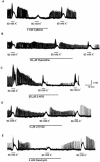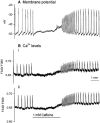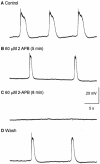Modulators of internal Ca2+ stores and the spontaneous electrical and contractile activity of the guinea-pig renal pelvis
- PMID: 11906949
- PMCID: PMC1573271
- DOI: 10.1038/sj.bjp.0704609
Modulators of internal Ca2+ stores and the spontaneous electrical and contractile activity of the guinea-pig renal pelvis
Abstract
1. The role of internal Ca(2+) stores in the generation of the rhythmic electrical and contractile activity in the guinea-pig proximal renal pelvis was examined using intracellular microelectrode and muscle tension recording techniques. 2. Ryanodine (30 microM) transiently increased contraction amplitude, while caffeine (0.5 - 3 mM) reduced contraction amplitude and frequency. Contractility was also reduced by 2-aminoethoxy-diphenylborate (2-APB 60 microM), xestospongin C (1 microM), U73122 (5 microM) and neomycin (4 mM), blockers of IP(3)-dependent release from Ca(2+) stores. 3. 60 mM K(+) saline-evoked contractions were reduced by caffeine (1 mM), U73122 (5 microM) and neomycin (4 mM), but little affected by ryanodine or 2-APB (60 microM). 4. Spontaneous action potentials consisting of an initial spike followed by a long plateau were recorded (frequency 8.6+/-1.0 min(-1)) in small urothelium-denuded strips of proximal renal pelvis. 5. Action potential discharge was blocked in 75 and 35% of cells by 2-APB (60 microM) and caffeine (1 mM), respectively. In the remaining cells, only a truncation of the plateau phase was observed. 6. Cyclopiazonic acid (CPA 10 microM for 10 - 180 min), blocker of CaATPase, transiently increased contraction frequency and amplitude. Action potential durations were increased 3.6 fold. Contraction amplitude and frequency slowly declined during a prolonged (>60 min) CPA exposure. 7. We conclude that the action potential in caffeine-sensitive cells and the shoulder component of caffeine-insensitive action potential arise from the entry of Ca(2+) through Ca(2+) channels. The inhibitory actions of modulators of internal Ca(2+) release were partially explained by a blockade of Ca(2+) entry.
Figures








Similar articles
-
Inositol trisphosphate-dependent Ca stores and mitochondria modulate slow wave activity arising from the smooth muscle cells of the guinea pig prostate gland.Br J Pharmacol. 2009 Apr;156(7):1098-106. doi: 10.1111/j.1476-5381.2009.00130.x. Epub 2009 Feb 25. Br J Pharmacol. 2009. PMID: 19243382 Free PMC article.
-
Role of intracellular Ca2+ in the K channel opener action of CGRP in the guinea-pig ureter.Br J Pharmacol. 1996 Jul;118(6):1493-503. doi: 10.1111/j.1476-5381.1996.tb15565.x. Br J Pharmacol. 1996. PMID: 8832077 Free PMC article.
-
Effect of the Ca(2+)-ATPase inhibitor, cyclopiazonic acid, on electromechanical coupling in the guinea-pig ureter.Br J Pharmacol. 1995 Jan;114(1):127-37. doi: 10.1111/j.1476-5381.1995.tb14916.x. Br J Pharmacol. 1995. PMID: 7536095 Free PMC article.
-
Electrical basis of peristalsis in the mammalian upper urinary tract.Clin Exp Pharmacol Physiol. 1998 May;25(5):310-21. doi: 10.1111/j.1440-1681.1998.tb02357.x. Clin Exp Pharmacol Physiol. 1998. PMID: 9612657 Review.
-
Pacemaker Mechanisms Driving Pyeloureteric Peristalsis: Modulatory Role of Interstitial Cells.Adv Exp Med Biol. 2019;1124:77-101. doi: 10.1007/978-981-13-5895-1_3. Adv Exp Med Biol. 2019. PMID: 31183823 Review.
Cited by
-
Role of Ca2+ entry and Ca2+ stores in atypical smooth muscle cell autorhythmicity in the mouse renal pelvis.Br J Pharmacol. 2007 Dec;152(8):1248-59. doi: 10.1038/sj.bjp.0707535. Epub 2007 Oct 29. Br J Pharmacol. 2007. PMID: 17965738 Free PMC article.
-
Interstitial cell of Cajal-like cells in the upper urinary tract.J Cell Mol Med. 2005 Jul-Sep;9(3):543-56. doi: 10.1111/j.1582-4934.2005.tb00487.x. J Cell Mol Med. 2005. PMID: 16202204 Free PMC article. Review.
-
Functions of ICC-like cells in the urinary tract and male genital organs.J Cell Mol Med. 2010 Jun;14(6A):1199-211. doi: 10.1111/j.1582-4934.2010.01043.x. Epub 2010 Feb 24. J Cell Mol Med. 2010. PMID: 20184664 Free PMC article. Review.
-
Comparison of signalling mechanisms involved in rat mesenteric microvessel contraction by noradrenaline and sphingosylphosphorylcholine.Br J Pharmacol. 2003 Jan;138(1):261-71. doi: 10.1038/sj.bjp.0705028. Br J Pharmacol. 2003. PMID: 12522098 Free PMC article.
-
Inositol trisphosphate-dependent Ca stores and mitochondria modulate slow wave activity arising from the smooth muscle cells of the guinea pig prostate gland.Br J Pharmacol. 2009 Apr;156(7):1098-106. doi: 10.1111/j.1476-5381.2009.00130.x. Epub 2009 Feb 25. Br J Pharmacol. 2009. PMID: 19243382 Free PMC article.
References
-
- EXINTARIS B., LANG R.J. Effects of nerve stimulation on spontaneously active preparations of the guinea pig ureter. Urol. Res. 1999a;27:328–335. - PubMed
Publication types
MeSH terms
Substances
LinkOut - more resources
Full Text Sources
Miscellaneous

